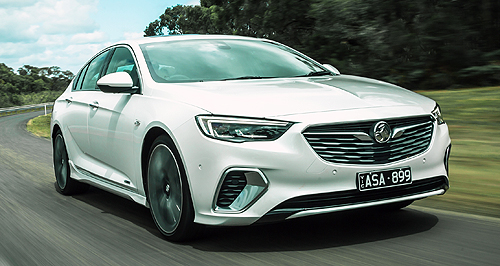News - Holden - CommodoreHolden reveals push for V6 in CommodoreStill six: Opel was happy with four-cylinder engine in its Insignia, but Holden went into battle to get a V6 for its Commodore version. Buick helped Holden win V6 for Commodore, but not preferred 3.0-litre twin-turbo8 Feb 2018 HOLDEN has revealed that the second-generation Opel Insignia on which the new ZB Commodore is based initially was to have a maximum of four cylinders in line with European preferences before Buick came on board to help Holden push for V6 versions. However, it is understood that the desired 3.0-litre twin-turbo V6 as used in some existing rear-drive Cadillac models such as the CT6 full-sized luxury sedan on the premium Omega platform in America was too expensive to re-engineer for a transverse front/all-wheel drive application for the all-new E2 global vehicle architecture underpinning the Insignia B/ZB program. Adding to that are the predicted limited global volumes that such a costly powertrain derivative would attract, while it probably would not even be offered in Western Europe in either Opel or Vauxhall guises anyway due to high consumption/emissions concerns. Holden vehicle development manager Jeremy Tassone, who revealed that Holden was part of the Insignia B program since its inception more than five years ago, said: “We wanted to make sure the (E2) architecture could take the V6 that Holden wanted. “Prior to Holden getting involved in this program there was no V6. Europe don’t take a V6 at all, as the 2.0-litre is their premium engine. So, we had to get in there, fight our case, present our data, and (tell Opel that) that it is very important for Australia to have a V6 and all-wheel drive.” Developing about 300kW of power and 542Nm of torque in its CT6 application, the 3.0-litre twin-turbo V6 would have been a more suitable SS-style performance flagship than the 235kW/381Nm 3.6-litre naturally aspirated V6 in the ZB VXR. Ironically the Cadillac’s Omega platform is the successor to the Australian-developed Zeta that underpinned all VE and VF Commodores and their derivatives. While the integration of the 3.6-litre atmo V6 into E2 was done at Opel in Russelsheim, Germany (the homeroom for Insignia B/ZB Commodore), Holden personnel led by lead vehicle dynamics engineer, Rob Trubiani, worked at GM’s Michigan headquarters to calibrate the engine for its Commodore (and Buick Regal and derivatives) application, since GM’s Global Propulsion Systems in America is where development for the V6 (and 2.0-litre turbo petrol engine) took place. Also, no Opel or Vauxhall Insignia B V6s exist. Mr Tassone said the 3.6-litre unit was the most efficient and economical way of getting an existing V6 shoehorned into the E2 architecture without blowing out costs for both General Motors and consumers requiring an affordable V6 with up to 2100kg of towing capacity (compared with 1800kg for the 2.0T). “It’s an evolution of the old V6,” he said. “Just hearing it you can tell straight away it’s a brand-new engine that’s very different in its characteristics – a lot more exhaust note through modified exhaust change we did into the car for us … with more power, AFM (GM’s cylinder cut-out tech to save fuel) and stop-start.” Although achieving better fuel consumption than before – exacerbated by the fact that the V6 powertrain and all-wheel drive collectively add 138kg of extra weight over the 2.0-litre front-drive equivalents – the calibration of the new nine-speed torque-converter automatic transmission to make the most of the 3.6-litre engine proved a challenge. “It’s all good and well to say you’ve got eight or nine speed automatic transmissions across the board, but to be honest, when I first heard it, I was a little bit of a sceptic,” Mr Tassone said. “I was thinking … already it’s a challenge not to have shift busyness … lag tipping on down-change … issues you get with a six-speed transmission could only get worse (with nine gears). “But we really wanted to focus on driveability on these cars – maybe even possibly to the detriment of fuel economy, we wanted to make sure the car was in the right gear at the right time ready to respond to the driver’s demand.” With Holden having more than 100 engineers at its Lang Lang Proving Ground calibrating engines and transmissions for the entire GM network globally, Mr Tassone said there was plenty of knowledge and experience behind the new Commodore’s tuning. Among these are new various modes such as uphill mode, downhill mode (which detect where the car is on a grade and adjusting the base shift pattern accordingly), shift stabilisation (monitoring how and when the driver is on and off the throttle to cut unnecessary up or down shifts), sports mode (with sensors helping ascertain the optimum response ratio through a wide range of circumstances) and VXR mode (which provides the most aggressive response algorithm), among other features. “Holden engaged throughout program… and we really got in early to make sure the cars were great to drive,” he said.  Read more6th of February 2018  RS 2.0T FWD set to be Holden Commodore best-sellerHolden Commodore SV6 successor to be the biggest fish in a smaller pond6th of February 2018  New Holden Commodore set for a short six yearsHolden MD confirms supplier Opel cannot re-enter Australia during Commodore stint6th of February 2018  Holden planned to build ZB Commodore in AustraliaNew Commodore based on Opel Insignia was chosen to replace VF on Elizabeth line |
Click to shareHolden articlesCommodore pricing
Motor industry news |















Facebook Twitter Instagram